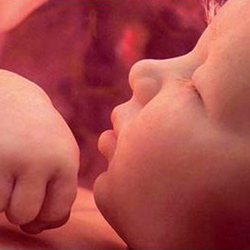The Brain
Your brain developed early—actually in weeks 4 and 5 (weeks 2 and 3 after conception).
Cells in the embryo’s outer layer or ectoderm grew rapidly in Week 5, dividing into developmental pathways that would govern whether they’d become skin and hair, or form your neural plate, the precursor of your brain and spinal cord.

At about the third or fourth week after conception, the neural tube begins to form and to show bulges that will become parts of the brain and spinal cord.
Early Brain Development
So three main parts of your brain formed this early. Atop of the neural tube, neuroepithelial cells formed the forebrain, midbrain and hindbrain. Your lower neural plate would become your spinal cord.
Soon your ventricles (fluid filled spaces) formed in the middle of the brain, and tiny grooves appeared there.
2-3 Months (weeks 10 to 14)
Your brain had a growth spurt! Your brain stem formed in the back of your brain, controlling your breathing and heartbeat. Your cerebellum, centre of your balance and coordination, emerged in the middle. Your forebrain separated into two intermediate parts, the diencephalon and telencephalon. Your diencephalon became the thalamus and hypothalamus, centres of your emotions and sensory perception. Your telencephalon produced your hippocampus, home of your short-term memory and sense of smell; your basal ganglia, control centre for movement, sensory information, and some types of learning; and your amygdala, an emotional interpreter of signals. In week 10, your cerebral cortex appeared. It’s the seat of “higher functions” of learning, language, and abstract thought (a centre that develops throughout life).

Week 19
Your growth spurt continues until about week 19. In the neural tube, two special cell types develop: the neurons think and control movement, the glial cells guide the building of the brain, especially the cerebellum.
In the second trimester, cells began to travel (migration), form communities (aggregation), and make connections that facilitate the communication necessary to brain function (synaptic formation). All of this activity prepares the brain for movement, learning, conscious thought, and memory.
Meanwhile, your skull began to harden from cartilage into bone. So the cortex acquired wrinkles to fit inside the hardening skull. These wrinkles are unique from person to person, although they follow a general pattern.
Formation of the Brain
Using time lapse photography, we can see the formation of the brain
Prenatal Brain Development





